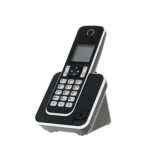April 9, 2024

Burda on Healthcare: Why Your Digital Front Door Needs a Side Analog Entrance
After the World Wide Web became a thing in the mid-1990s, people called me a technology luddite. I supervised 14 reporters at the time, and I was the only person opposed to giving each reporter access to the internet on their individual work computers. I favored a centralized computer or set of computers with internet access that reporters could use when they wanted to look something up.
 Despite my concern that people would use internet access at their workstations to do anything but work, I was voted down, and the internet era dawned in our newsroom. Turns out I was wrong, the internet became an invaluable tool to do our jobs. We even paid people to take computer-assisted journalism classes. Email me if you remember those.
Despite my concern that people would use internet access at their workstations to do anything but work, I was voted down, and the internet era dawned in our newsroom. Turns out I was wrong, the internet became an invaluable tool to do our jobs. We even paid people to take computer-assisted journalism classes. Email me if you remember those.
Looking back on it, what I feared wasn’t the technology. What I feared was people using the internet at work for personal reasons and not doing their jobs. It’s like what 4sight Health founder and CEO David W. Johnson says about private equity. PE is amoral, similar to nuclear energy. It’s not inherently good or evil. It’s people who use it for good or evil. Same with internet access in our newsroom at the time.
What does all this have to do with telemedicine? Here’s my story.
Steroids and an Inhaler, Please
 Every spring, when the weather in the western suburbs of Chicago gets warmer, I go outside as soon as possible to ride my bike on the nearby Illinois Forest Preserve paths and to start working on our vegetable garden. But I suffer from seasonal allergies. Without fail, my first lengthy time spent outside triggers my allergies, which, in turn, triggers something that’s like a mix of bronchitis, asthma and laryngitis. I can breathe but not without coughing or losing my voice.
Every spring, when the weather in the western suburbs of Chicago gets warmer, I go outside as soon as possible to ride my bike on the nearby Illinois Forest Preserve paths and to start working on our vegetable garden. But I suffer from seasonal allergies. Without fail, my first lengthy time spent outside triggers my allergies, which, in turn, triggers something that’s like a mix of bronchitis, asthma and laryngitis. I can breathe but not without coughing or losing my voice.
It happens every year, and it doesn’t go away until I take a course of steroids and briefly use an inhaler, both prescribed by my primary care physician (PCP). The first few years it happened, I’d also get a chest X-ray to rule out pneumonia, and a course of antibiotics just in case it was pneumonia of the bacterial variety. Now we skip the chest X-ray and antibiotics and go straight to the steroids and inhaler. I don’t need the extra radiation, and I don’t want to contribute to the growth of antibiotic-resistant superbugs.
I know what’s wrong with me and what the right treatment is. My PCP knows what’s wrong with me and what the right treatment is. The problem is, my PCP won’t prescribe the steroids and the inhaler without seeing me. Now, I know of no federal or state law that requires a physician to see a patient before the doctor can prescribe a drug unless the drug is a controlled substance. There may be state licensing boards or state medical boards or medical specialty boards that require a physician to see a patient before they can write a prescription, but those rules are written by doctors themselves.
Why? Maybe to give doctors some protection from pill-happy patients? Maybe to give doctors an excuse to bill for an office visit that lasts about five minutes? Maybe to prevent what organized medicine calls scope-of-practice creep by other licensed clinicians? I don’t know.
What I do know is that it’s a pain in the ass every spring to set up an appointment to see my PCP — who is a very nice person, by the way — to get my steroids and my inhaler.
The Telemedicine Disconnect
Enter telemedicine. This spring, which came earlier than usual, I decided to use technology for good, not evil. Rather than setting up an appointment to see my PCP in person after I started coughing and losing my voice, I decided to set up a telemedicine visit with any available clinician in the practice to get my prescriptions filled.
I didn’t wait weeks to see my PCP. I didn’t wait hours in urgent care to see a physician assistant or nurse practitioner. All I had to do was wait about two hours until the next available telemedicine appointment that day. I set it up, and the practice would text me a link on my mobile phone, which is connected to our home Wi-Fi. All I had to do was click on the link, and I would be connected virtually to a doctor.
At 6:12 p.m. on Wednesday, March 13, I got a text from the practice that says my telemedicine visit has started. It instructed me to click on the link in the text to be connected to Tatiana Doyle, M.D., who was on the call. The URL indicated that the virtual visit would take place on the Doximity telehealth platform.
I clicked on the link, and Doximity tells me its app is loading on my phone. And loading. And loading. And loading. And loading.
I text back and say the app isn’t loading. The practice texts back and tells me the text is a no-reply text message. And, if I’m a patient, to please contact my provider for more information. I could also click on another link to a Doximity FAQ page for troubleshooting tips. For the record, I have a newer iPhone.
As I’m reading that text, I get another from the practice that tells me Dr. Doyle is waiting for me on the call and to click here to be connected. I try again. Loading. And loading. And loading. And loading. How long will Dr. Doyle wait? What if the pharmacy runs out of steroids and inhalers? What if I have to wait weeks to see my PCP? What a fool I’ve been to trust technology. I hate technology. I should have never let those reporters have access to the internet.
Landline Becomes a Lifeline
 Then, a miracle happens. Our landline rings. I couldn’t get to it fast enough the first time because the landline phone is on another floor. But then it rings again. I picked it up, and it was Dr. Doyle. She was very nice on the phone. She wasn’t annoyed that I was late. I explained my medical condition. She got it, especially the part about being a good steward of antibiotics. She called in the prescriptions. I picked them up that night. A week later I was talking without coughing or losing my voice.
Then, a miracle happens. Our landline rings. I couldn’t get to it fast enough the first time because the landline phone is on another floor. But then it rings again. I picked it up, and it was Dr. Doyle. She was very nice on the phone. She wasn’t annoyed that I was late. I explained my medical condition. She got it, especially the part about being a good steward of antibiotics. She called in the prescriptions. I picked them up that night. A week later I was talking without coughing or losing my voice.
That positive digital health outcome would not have been possible without an analog workaround. My landline. Obviously, my home number was in my patient file, and Dr. Doyle was smart enough to look it up and call me directly. She probably saw my age and thought, “I bet this guy still has a landline.”
So, to all you providers out there who are building digital front doors, make sure you have a side analog entrance when your shiny new technology glitches, your app doesn’t load or your server goes down.
Thanks for reading.





